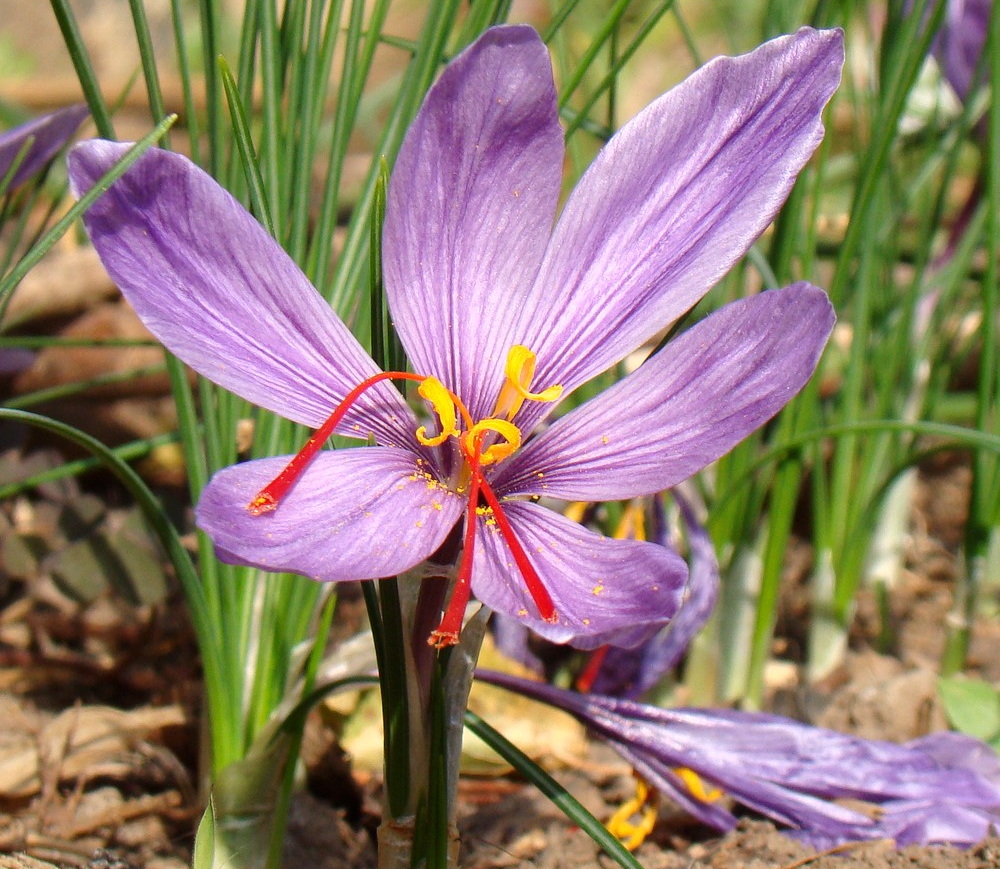AMINO ACID AND ELEMENTAL COMPOSITIONS OF FLOWERS OF PLANT CROCUS SATIVUS L.
UDK 635.716:577.112.38:577.118
Abstract
Amino acids (AA) of individual parts (stigma, stamens, petals) of flowers of Crocus sativus L. (saffron) growing in Uzbekistan were studied for the first time. 20 AAs were identified in the samples, which 8 were nonessential, 8 were irreplaceable, 4 were partially nonessential amino acids. The total amount of AA in the stigmas was 11.35001 mg/g, in the stamens 60.85032 mg/g, in the petals 48.7104 mg/g. Essential AAs are found in approximately equal amounts in petals (15.73832 mg/g) and stamens (14.84272 mg/g), partially replaceable AAs dominate in stamens (29.48137 mg/g). According to the results of a comparative analysis, the stamens of the flowers of Crocus sativus L. are quantitatively richer in amino acids than their other parts. For the first time, the elemental composition of individual parts of the flowers of Crocus sativus L. was studied by optical emission spectrometry with inductively coupled argon plasma. It was found that the predominant elements in the raw material are K, Na, Mg, Ca, Fe, P, Al and Ga. Flower petals are enriched with macro- and microelements. The obtained data allow us to consider the petals and stamens of Crocus sativus L., which are waste products of saffron production, as a promising source of mineral elements and valuable amino acids with a wide range of pharmacological activity, based on them can be used to develop new food additives and pharmaceutical substances.
Downloads
Metrics
References
Nishanbayev S.Z., Bobakulov Kh.M., Khotamdzhanov A.Kh., Okhundedayev B.S., Sham'yanov I.D., Tukhtayev B.O. Universum: Khimiya i biologiya: elektronnyy nauchnyy zhurnal, 2019, no. 7 (61). URL: http://7universum.com/ru/nature/archive/item/7578. (in Russ.).
Bekker R.A., Bykov Yu.V. Siberian Journal of Life Sciences and Agriculture, 2018, vol. 10, no. 1, pp. 90–123. DOI: 10.12731/wsd-2018-1-90-123. (in Russ.).
Siracusa L., Gresta F., Ruberto G. Nova Science Publishers, 2011, pр. 1–33.
Amanpour A., Sonmezdag A.S., Kelebek H., Selli S. Food Chemistry, 2015, vol. 182, pp. 251–256. DOI: 10.1016/j.foodchem.2015.03.005.
El-Mahrouk M.E., Dewir Y.H., El-Ramady H., Seliem M.K. Horticulturae, 2023, vol. 9, no. 3, 377. DOI: 10.3390/horticulturae9030377.
Chaudhary N., Kothari D., Walia S., Ghosh A., Vaghela P., Kumar R. Frontiers in Plant Science, 2023, vol. 15, no. 14, 1097682. DOI: 10.3389/fpls.2023.1097682.
Kumar R., Singh V., Devi K., Sharma M., Singh M.K., Ahuja P.S. Food Reviews International, 2009, vol. 25, no. 1, pp. 44–85. DOI: 10.1080/87559120802458503.
Kuvayeva Z.I. Aktual'nyye voprosy farmatsii Respubliki Belarus': sbornik trudov 9-go s"yezda farmatsevticheskikh rabotnikov Respubliki Belarus': v 2 ch. [Current issues in pharmacy of the Republic of Belarus: collection of proceed-ings of the 9th Congress of Pharmaceutical Workers of the Republic of Belarus: in 2 parts]. Minsk, 2016, part. 1, pp. 163–167. (in Russ.).
Kruglaya A.A. Farmatsiya i farmakologiya, 2016, vol. 4, no. 6, pp. 33–43. DOI: 10.19163/2307-9266-2016-4-6-33-43. (in Russ.).
Gashimova U.F., Babayev Kh.F., Shukyurova P.A., Gasanova S.I. Klinicheskaya gerontologiya, 2018, no. 5-6, pp. 14–18. DOI: 10.26347/1607-2499201805-06014-018. (in Russ.).
Lovkova M.Ya., Rabinovich A.M., Ponomareva S.M., Buzuk G.N., Sokolova S.M. Pochemu rasteniya lechat. [Why plants are treated]. Moscow, 1989, 256 p. (in Russ.).
D’Archivio A.A., Giannitto A., Incani A., Nisi S. Food Chemistry, 2014, vol. 157, pp. 485–489. DOI: 10.1016/j.foodchem.2014.02.068.
Jadouali S.M., Atifi H., Mamouni R., Majourhat Kh., Bouzoubaâ Z., Laknifli A., Faouzi A. Journal of the Saudi Socie-ty of Agricultural Sciences, 2019, vol. 18, pp. 476–480. DOI: 10.1016/j.jssas.2018.03.007.
Fahima N.K., Fakoor Janatib S.S., Feizy J. GIDA – Journal of Food, 2012, vol. 37, no. 4, pp. 197–201.
Makhmudova Sh.R., Yuldasheva N.K., Nishanbaev S.Z., Gusakova S.D. Abstract International Sciences Conference ”Actual Problem of the Chemistry of Natural Compounds”. Tashkent, 2023, p. 148.
Coven S.A., Strydom D.J. Journal of Analytical Biochemistry, 1988, vol. 17, no. 1, pp. 1–16. DOI: 10.1016/0003-2697(88)90512-x.
Tkachev V.O. Razrabotka napitkov dlya sportivnogo pitaniya, obogashchennykh funktsional'nymi ingrediyentami: diss. … kand. tekhn. nauk. [Development of sports nutrition drinks enriched with functional ingredients: dissertation. ...cand. tech. Sci.]. Troitsk, 2021, 177 p. (in Russ.).
Rol' biologicheski aktivnykh dobavok v sisteme podgotovki sportsmenov: metodicheskoye posobiye [The role of dietary supplements in the system of training athletes: methodological manual], ed. V.A. Kurashvili. Moscow, 2018, 116 p. (in Russ.).
Galenko M.S., Gravel' I.V., Vel'ts N.Yu., Alyautdin R.N. Bezopasnost' i risk farmakoterapii, 2021, no. 9 (2), pp. 61–68. DOI: 10.30895/2312-7821-2021-9-2-61-68. (in Russ.).
Kamanina I.Z., Kaplina S.P., Salikhova F.S. Nauchnoye obozreniye, 2019, no. 1, pp. 29–34. (in Russ.).
Burchenko T.V. Uspekhi sovremennogo yestestvoznaniya, 2011, no. 8, pp. 25–27. (in Russ.).
Siromlya T.I., Myadelets M.A. Sovremennyye problemy nauki i obrazovaniya, 2015, no. 6. URL: https://science-education.ru/ru/article/view?id=22917. (in Russ.).
OFS.1.5.3.0009.15. Opredeleniye soderzhaniya tyazhelykh metallov i mysh'yaka v lekarstvennom rastitel'nom syr'ye i lekarstvennykh rastitel'nykh preparatakh [OFS.1.5.3.0009.15. Determination of the content of heavy metals and arsenic in medicinal plant raw materials and medicinal herbal preparations]. URL: http://pharmacopoeia.ru/ofs-1-5-3-0009-15-opredeleniesoderzhaniya-tyazhelyh-metallov-i-myshyaka-v-lekarstvennomrastitelnom-syre-i-lekarstvennyh-rastitelnyh-preparatah. (in Russ.).

Copyright (c) 2024 chemistry of plant raw material

This work is licensed under a Creative Commons Attribution 4.0 International License.

This work is licensed under a Creative Commons Attribution 4.0 International License.
The authors, which are published in this journal, agree to the following conditions:
1. Authors retain the copyright to the work and transfer to the journal the right of the first publication along with the work, at the same time licensing it under the terms of the Creative Commons Attribution License, which allows others to distribute this work with the obligatory indication of the authorship of this work and a link to the original publication in this journal .
2. The authors retain the right to enter into separate, additional contractual agreements for the non-exclusive distribution of the version of the work published by this journal (for example, to place it in the university depository or to publish it in a book), with reference to the original publication in this journal.
3. Authors are allowed to post their work on the Internet (for example, in a university repository or on their personal website) before and during the review process of this journal, as this may lead to a productive discussion, as well as more links to this published work.











